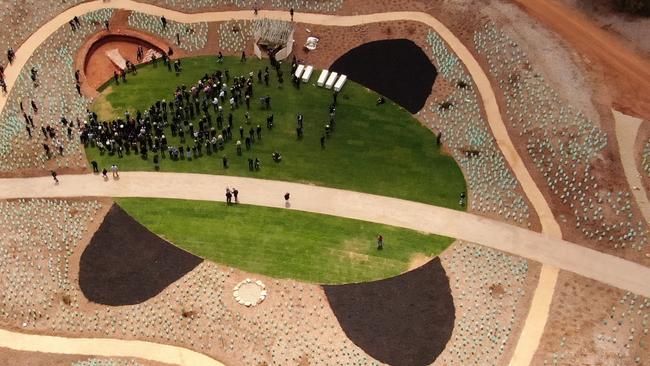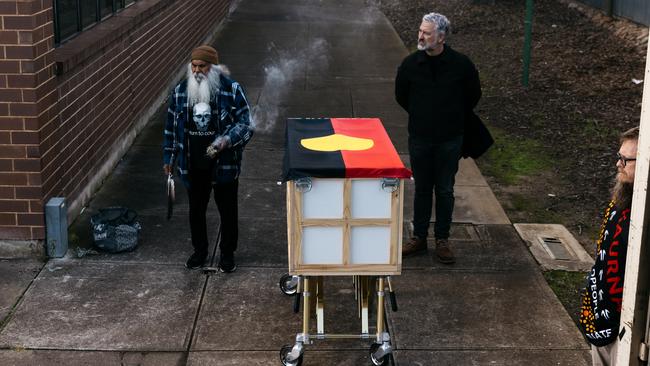Jess Adamson: Bones of thousands of people held by SA Museum being laid to rest in new cemetery
The remains of thousands of people have been held in a secret vault of the SA Museum. Now they are being taken home, writes Jess Adamson.
Opinion
Don't miss out on the headlines from Opinion. Followed categories will be added to My News.
In a giant warehouse, not far from Adelaide Airport, there’s a dark, locked room.
It’s been a secret-keeper for decades. Until now.
The warehouse is the South Australian Museum’s collections storage, an overflow of artefacts and exhibits that simply don’t fit at North Tce.
Within that storage facility is another room, the Keeping Place. Up until recently, that locked room has held the bones of 4000 South Australians in neatly marked boxes – mothers and their babies, men, young and old, toddlers and teenagers.
No one knows who they are. But we know where they’ve come from.
They are the ancestral remains of Aboriginal people, deliberately disturbed from traditional burial sites across Adelaide for scientific reasons – and accidentally dug up as we built the roads we drive on, the offices we work in and the homes we live in.
Our lives are built upon their unrest. But now, in the biggest repatriation in Australia’s history and one of the biggest in the world, the Old People are going home.
It’s a monumental moment in our state’s history and it’s long overdue. The process has been quietly unfolding over recent months at a purpose-built burial site at Smithfield.
Local elders Uncle Jeffrey Newchurch, Uncle Major “Moogy” Sumner and Aunty Madge Wanganeen have led the charge, supported by the SA Museum and the Adelaide Cemeteries Authority, the state government and the University of Adelaide.
It’s called Wangayarta – in Kaurna language “wanga” means grave and “yarta” means land, earth, ground, soil, country. The translation is Burial Place. But it seems like so much more than that.
From the air you see the shape of the Kaurna shield. On the ground, you can smell the native plants, medicinal herbs and bushes, deliberately chosen to be used in smoking ceremonies. They are the plants the ancestors grew up with.
Soil has been brought in from the north, south, east and west of the Adelaide Plains so everyone is reburied in the country they once called home. So far, 350 Kaurna Old People have been laid to rest in two separate ceremonies, with similar numbers to follow in the years ahead.

Aboriginal people have cultural obligations to bury their ancestors in an appropriate way.
It’s surely not too much to ask? Imagine for one moment your family members kept in a box and locked in a shed for more than a century.
As the remains are gently removed from the boxes, they’re wrapped in brown paper, cleansed in a smoking ceremony and taken in a procession of hearses to Wangayarta.
Kaurna and Ngarrindjeri elder Uncle Moogy is there. “I talk to them in our language, I let them know who I am, I sing songs. The most important thing is to let them know that we’re here to take them home,” he says. “In the first reburial, (former premier) Steven Marshall handed me one of the Old People’s remains and that person, he was dug up and put in the museum and then kept at Netley in a box since 1899.
“That’s more than 100 years – it’s time that people let go of them.”
The 2ha at Smithfield have been given by the Adelaide Cemeteries Authority and dedicated to Kaurna ancestors in perpetuity. That means the ancestors will never be disturbed again. That’s a promise from the state government. Therefore, it’s a promise from all of us.

What I love about Wangayarta is that we’re facing the past together. We can acknowledge the awful things that have happened in the past, without it being our fault.
The reburials are confronting for everyone involved but they’re saying sorry for the pain our forebears caused. In the words of SA Museum’s John Carty, “we’re no longer perpetuating the silence”.
John and his team have chosen not to look away from the collection under their roof that’s rarely been spoken about. He took his family to the most recent reburial and witnessed a powerful moment.
It came when Uncle Moogy unexpectedly asked for help from the non-Aboriginal people present to carry 220 ancestors to their final resting place.
“My 11-year-old is standing there with an ancestor in his hands.
“I asked him if he was OK but he just said, ‘Yes Dad, I want to do this’,” John says. “There were adults crying in the line – they couldn’t believe the trust that had been placed in them by Kaurna. It felt like a shift was happening in the life and conscience of our city.”
Black and white, shoulder to shoulder, sharing the burden together. Uncle Moogy says it felt good to see people willing to help.
“When they’re standing there holding the ancestor and handing them down to us in the pit, they could feel the spirit, you could see the emotion in them.”
That is what reconciliation looks like.
Plans are in place to create more reburial sites with other Aboriginal communities across the state. The River Murray mob are the next group bravely beginning this emotional task. But perhaps the most disturbing chapter in this part of our history is the number of ancestors left in museums and universities overseas.
It’s estimated there are thousands in the UK alone. Their bones were treated as a commodity in a macabre trade with a hungry crowd of anatomists, anthropologists, and private collectors. The mind boggles to think what we got in return.
Uncle Moogy has spent 40 years travelling the globe, successfully negotiating to bring these ancestors back to country.
“They’ve made a lot of money out of our people’s remains, they’re educating people about the human body and yet it wasn’t until 1967 that we were recognised as humans,’’ he says. “It’s not science for our people, their spirit is still wandering.
“They’re sitting in a box in a different part of the world they didn’t even know existed. The world to our people was here in this country, under our sky, that’s their world.”
Hundreds have been brought back to SA but the process will take many years. It might not be completed in Uncle Moogy’s lifetime but it also can’t be up to him alone.
As Wangayarta has shown us so beautifully, repatriation is everyone’s business.
It’s up to all of us now to make sure these ancestors come home.




